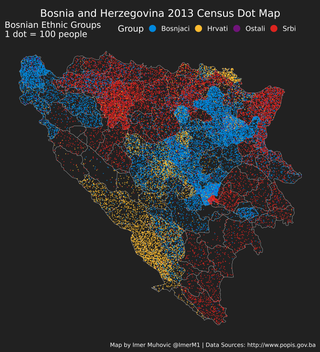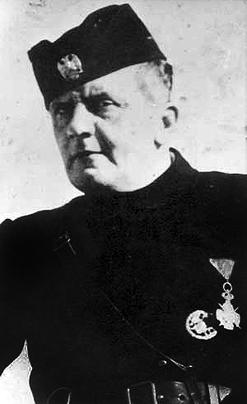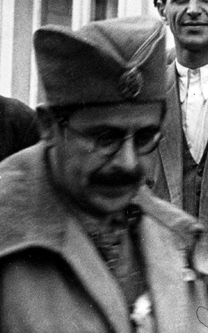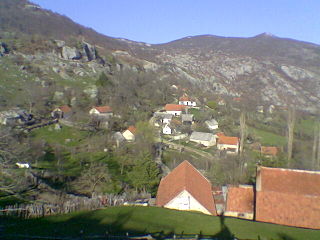Related Research Articles

Alija Izetbegović was a Bosnian politician, lawyer, Islamic philosopher and author, who in 1992 became the first president of the Presidency of the newly independent Republic of Bosnia and Herzegovina.

The Party of Democratic Action is a Bosniak nationalist, conservative political party in Bosnia and Herzegovina.

More than 96% of population of Bosnia and Herzegovina belongs to one of its three autochthonous constituent peoples : Bosniaks, Serbs and Croats. The term constituent refers to the fact that these three ethnic groups are explicitly mentioned in the constitution, and that none of them can be considered a minority or immigrant. The most easily recognisable feature that distinguishes the three ethnic groups is their religion, with Bosniaks predominantly Muslim, Serbs predominantly Eastern Orthodox, and Croats Catholic.
"Muslims" is a designation for the ethnoreligious group of Serbo-Croatian-speaking Muslims and people of Muslim heritage, inhabiting mostly the territory of the former Socialist Federal Republic of Yugoslavia. The term, adopted in the 1971 Constitution of Yugoslavia, groups together a number of distinct South Slavic communities of Islamic ethnocultural tradition. Prior to 1993, a vast majority of present-day Bosniaks self-identified as ethnic Muslims, along with some smaller groups of different ethnicity, such as Gorani and Torbeši. This designation did not include Yugoslav non-Slavic Muslims, such as Turks, some Romani people and majority of Albanians.

Islam is the most widespread religion in Bosnia and Herzegovina. It was introduced to the local population in the 15th and 16th centuries as a result of the Ottoman conquest of Bosnia and Herzegovina.

The Catholic Church in Bosnia and Herzegovina is a part of the worldwide Catholic Church under the spiritual leadership of the pope in Rome.

After the Kingdom of Yugoslavia was invaded by the Axis powers during World War II, all of Bosnia was ceded to the newly created Independent State of Croatia. Axis rule in Bosnia led to widespread persecution and mass-killings of native undesirables and anti-fascists. Many Serbs themselves took up arms and joined the Chetniks, a Serb nationalist and royalist resistance movement that conducted ineffective guerrilla warfare against the occupying Nazi forces. On 12 October 1941 a group of 108 notable Muslim citizens of Sarajevo signed the Resolution of Sarajevo Muslims by which they condemned the persecution of Serbs organized by Ustaše, made distinction between Muslims who participated in such persecutions and whole Muslim population, presented information about the persecutions of Muslims by Serbs and requested security for all citizens of the country, regardless of their identity.

The history of Jews in Bosnia and Herzegovina spans from the arrival of the first Bosnian Jews as a result of the Spanish Inquisition to the survival of the Bosnian Jews through the Holocaust and the Yugoslav Wars. Judaism and the Jewish community in Bosnia and Herzegovina has one of the oldest and most diverse histories in the former Yugoslav states, and is more than 500 years old, in terms of permanent settlement. Then a self-governing province of the Ottoman Empire, Bosnia was one of the few territories in Europe that welcomed Jews after their expulsion from Spain.

The Croats of Bosnia and Herzegovina, often referred to as Bosnian Croats or Herzegovinian Croats, are native and the third most populous ethnic group in Bosnia and Herzegovina, after Bosniaks and Serbs, and are one of the constitutive nations of Bosnia and Herzegovina. Croats of Bosnia and Herzegovina have made significant contributions to the culture of Bosnia and Herzegovina. Most Croats declare themselves Catholics and speakers of the Croatian language.
The State Anti-fascist Council for the National Liberation of Bosnia and Herzegovina, commonly abbreviated as the ZAVNOBiH, was convened on 25 November 1943 in Mrkonjić Grad during the World War II Axis occupation of Yugoslavia. It was established as the highest representative and legislative body in the territory of Bosnia and Herzegovina under control of the Yugoslav Partisans.
The Islamic Declaration is an essay written by Alija Izetbegović (1925–2003), republished in 1990 in Sarajevo, SR Bosnia and Herzegovina, SFR Yugoslavia. It presents his views on Islam and modernization. The treatise attempts to reconcile Western-style progress with Islamic tradition and issues a call for "Islamic renewal". The work was later used against Izetbegović and other pan-Islamists in a 1983 trial in Sarajevo, which resulted in him being sentenced to 14 years' imprisonment. He was released after two years.

Dobroslav Jevđević was a Bosnian Serb politician and self-appointed Chetnik commander in the Herzegovina region of the Axis-occupied Kingdom of Yugoslavia during World War II. He was a member of the interwar Chetnik Association and the Organisation of Yugoslav Nationalists, a Yugoslav National Party member of the National Assembly, and a leader of the opposition to King Alexander between 1929 and 1934. The following year, he became the propaganda chief for the Yugoslav government.

Adil Zulfikarpašić was a Bosnian intellectual and politician who served as vice president of the Republic of Bosnia and Herzegovina, during the Bosnian War of the 1990s, under the first president of the Presidency of the Republic of Bosnia and Herzegovina Alija Izetbegović. After the war he retired from politics and opened the Bosniak Institute, a museum in Sarajevo focused on the Bosniak culture.

Bosnia and Herzegovina fell under Austro-Hungarian rule in 1878, when the Congress of Berlin approved the occupation of the Bosnia Vilayet, which officially remained part of the Ottoman Empire. Three decades later, in 1908, Austria-Hungary provoked the Bosnian Crisis by formally annexing the occupied zone, establishing the Condominium of Bosnia and Herzegovina under the joint control of Austria and Hungary.

Operation Alfa was an offensive carried out in early October 1942 by the military forces of Italy and the Axis puppet state, the Independent State of Croatia (NDH), supported by Chetnik forces under the control of vojvoda Ilija Trifunović-Birčanin. The offensive was directed against the communist-led Partisans in the Prozor region, then a part of the NDH. The operation was militarily inconclusive, and in the aftermath, Chetnik forces conducted mass killings of civilians in the area.
The Bosniaks are a South Slavic ethnic group native to the Southeast European historical region of Bosnia, which is today part of Bosnia and Herzegovina, who share a common Bosnian ancestry, culture, history and language. They primarily live in Bosnia, Serbia, Montenegro, Croatia, Kosovo as well as in Austria, Germany, Turkey and Sweden. They also constitute a significant diaspora with several communities across Europe, the Americas and Oceania.

Mehmed Handžić was a Bosnian Islamic scholar, theologian and politician. Handžić was the leader of the Islamic revivalist movement in Bosnia and the founder of the religious association El-Hidaje. He was one of the authors of the Resolution of Sarajevo Muslims and the chairman of the Committee of National Salvation.
The Resolution of Sarajevo Muslims or Muslim Resolution of 1941 was one of the Resolutions of Muslims from Bosnia and Herzegovina declared by 108 notable Muslim citizens of Sarajevo during the Second World War in Sarajevo on October 12, 1941.

Ismet Popovac was a Bosnian Muslim lawyer and physician who led a Muslim Chetnik militia known as the Muslim People's Military Organization (MNVO) in Bosnia and Herzegovina during World War II. He was active in pre-war Yugoslav politics, becoming a member of the Serbian Muslim cultural organization Gajret and serving as the mayor of Konjic, a town in northern Herzegovina. He is also said to have been candidate for Vladko Maček's electoral list, but was left without a job in the Yugoslav state government after the creation of the Banovina of Croatia in August 1939.

In June 1941, Serbs in eastern Herzegovina rebelled against the authorities of the Independent State of Croatia, an Axis puppet state established during World War II on the territory of the defeated and occupied Kingdom of Yugoslavia. As the NDH imposed its authority, members of the fascist Ustaše ruling party began a genocidal campaign against Serbs throughout the country. In eastern Herzegovina, the Ustaše perpetrated a series of massacres and attacks against the majority Serb population commencing in the first week of June. Between 3 and 22 June 1941, spontaneous clashes occurred between NDH authorities and groups of Serbs in the region.
References
- Bougarel, Xavier (1997). "From Young Muslims to Party of Democratic Action: the Emergence of a Pan-Islamist Trend in Bosnia-Herzegovina". Islamic Studies. Islamabad: Islamic Research Institute, International Islamic University. 36 (2/3: Islam in the Balkans): 533–549. ISSN 2710-5326. JSTOR 23076211. S2CID 146579411.